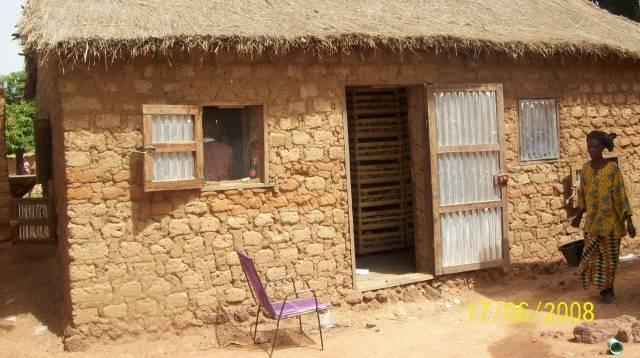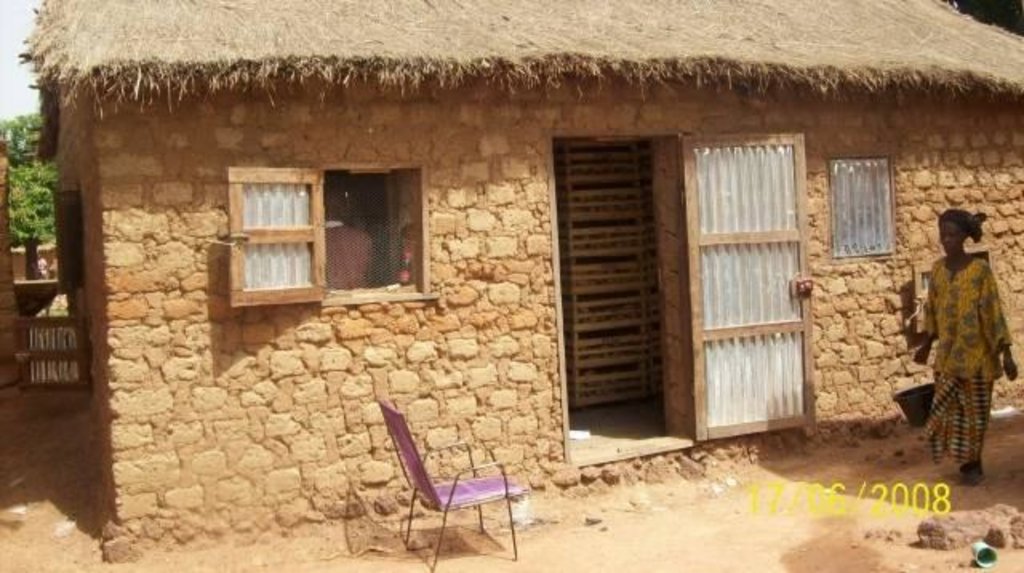Ventilated storehouses for highly perishable produce [Mali]
- Creation:
- Update:
- Compiler: Dieter Nill
- Editor: –
- Reviewers: Fabian Ottiger, Alexandra Gavilano
Case aérée de conservation des produits maraichers facilement périssables (French)
technologies_1640 - Mali
View sections
Expand all Collapse all1. General information
1.2 Contact details of resource persons and institutions involved in the assessment and documentation of the Technology
SLM specialist:
Assarki Oumar
Agricultural Competitiveness and Diversification Programme (PCDA)
Mali
Name of project which facilitated the documentation/ evaluation of the Technology (if relevant)
Manual of Good Practices in Small Scale Irrigation in the Sahel (GIZ )Name of the institution(s) which facilitated the documentation/ evaluation of the Technology (if relevant)
Deutsche Gesellschaft für Internationale Zusammenarbeit (GIZ) - GermanyName of the institution(s) which facilitated the documentation/ evaluation of the Technology (if relevant)
Agricultural Competitiveness and Diversification Programme (PCDA) - Mali1.3 Conditions regarding the use of data documented through WOCAT
The compiler and key resource person(s) accept the conditions regarding the use of data documented through WOCAT:
Yes
2. Description of the SLM Technology
2.1 Short description of the Technology
Definition of the Technology:
The aim of this practice is to improve the preservation and storage of potato tubers in rural areas.
2.2 Detailed description of the Technology
Description:
Ventilated storehouses are designed to store cash-crops and seed potatoes in conditions suitable for minimising damage and to hold back stock until market prices rise. The facilities are mudbrick, thatched outbuildings with external dimensions of 7.5 metres long by 5.9 metres wide. The stock quantity is 5,000 to 10,000 kilograms. The preservation period is six months, compared to three months using a traditional system. The loss rate is less than 20%.
Establishment / maintenance activities and inputs: No plant-health treatments are used. Every two weeks, checking for damaged tubers is required (to control rot).
Roles of the actors involved: The PCDA (Agricultural Competitiveness and Diversification Programme) funds, monitors and provides support. The promoter owns the site and provides a 25% personal contribution. The research and oversight bodies (ROBs) provide advisory support, monitor activities on the ground and deliver reports.
Natural / human environment: Given its economic benefits, most promoters have adopted this storage system. Others have built storehouses of this kind without any subsidies from the PCDA.
2.3 Photos of the Technology
2.5 Country/ region/ locations where the Technology has been applied and which are covered by this assessment
Country:
Mali
Region/ State/ Province:
Mali
Further specification of location:
Zignasso and Bamadougou (Sikasso)
Comments:
Zignasso 1 site, Sikasso Circle
Zignasso 2 site, Sikasso Circle
Bamadougou site, Sikasso Circle
2.6 Date of implementation
If precise year is not known, indicate approximate date:
- less than 10 years ago (recently)
2.7 Introduction of the Technology
Specify how the Technology was introduced:
- through projects/ external interventions
Comments (type of project, etc.):
Since 2007, through Agricultural Competitiveness and Diversification Programme (PCDA)
3. Classification of the SLM Technology
3.1 Main purpose(s) of the Technology
- create beneficial economic impact
- create beneficial social impact
3.2 Current land use type(s) where the Technology is applied
Land use mixed within the same land unit:
Yes
Specify mixed land use (crops/ grazing/ trees):
- Agro-silvopastoralism

Cropland
- Annual cropping
Annual cropping - Specify crops:
- root/tuber crops - potatoes
- rice
Number of growing seasons per year:
- 1
Specify:
Longest growing period in days: 120 Longest growing period from month to month: August-November

Settlements, infrastructure
- Settlements, buildings
Comments:
Major cash crop: Potato
Major food crop: Potato, rice
Major land use problems (compiler’s opinion): lack of storage possibility for highly perishable produce
Mixed: (eg agro-pastoralism, silvo-pastoralism): Yes
Livestock density: 1-10 LU /km2
3.4 Water supply
Water supply for the land on which the Technology is applied:
- mixed rainfed-irrigated
3.5 SLM group to which the Technology belongs
- post-harvest measures
3.6 SLM measures comprising the Technology

management measures
- M7: Others
Comments:
Main measures: management measures
Specification of other management measures: Ventilated storehouse
3.7 Main types of land degradation addressed by the Technology
3.8 Prevention, reduction, or restoration of land degradation
Specify the goal of the Technology with regard to land degradation:
- prevent land degradation
4. Technical specifications, implementation activities, inputs, and costs
4.1 Technical drawing of the Technology
Technical specifications (related to technical drawing):
Technical knowledge required for field staff / advisors: high
Technical knowledge required for land users: low
Main technical functions: promotion of vegetation species and varieties (quality, eg palatable fodder), improved conditions to store highly perishable produce
Other type of management: ventilated storehouses
4.2 General information regarding the calculation of inputs and costs
other/ national currency (specify):
CFA Franc
If relevant, indicate exchange rate from USD to local currency (e.g. 1 USD = 79.9 Brazilian Real): 1 USD =:
517.0
4.3 Establishment activities
| Activity | Timing (season) | |
|---|---|---|
| 1. | Construction of ventilated storehouse. The facilities are mudbrick, thatched outbuildings with external dimensions of 7.5 metres long by 5.9 metres wide |
4.5 Maintenance/ recurrent activities
| Activity | Timing/ frequency | |
|---|---|---|
| 1. | Every two weeks, checking for damaged tubers is required (to control rot). |
4.7 Most important factors affecting the costs
Describe the most determinate factors affecting the costs:
Investment costs: 584,000 CFA francs (1,136 Dollar): crates – 400,000 CFA francs, storehouses – 184,000 CFA francs.
Preservation costs: each kilogram of stored potato will incur an extra cost of 53 CFA francs (0.10 Dollar).
Break-even point in terms of revenue: once turnover moves beyond 105,510 CFA francs, the conservation activities begin to become profitable.
Break-even point in terms of quantity: a minimum stock of 313 kilograms must be stored for the activity to be profitable.
5. Natural and human environment
5.1 Climate
Annual rainfall
- < 250 mm
- 251-500 mm
- 501-750 mm
- 751-1,000 mm
- 1,001-1,500 mm
- 1,501-2,000 mm
- 2,001-3,000 mm
- 3,001-4,000 mm
- > 4,000 mm
Agro-climatic zone
- semi-arid
Thermal climate class: tropics
5.2 Topography
Slopes on average:
- flat (0-2%)
- gentle (3-5%)
- moderate (6-10%)
- rolling (11-15%)
- hilly (16-30%)
- steep (31-60%)
- very steep (>60%)
Landforms:
- plateau/plains
- ridges
- mountain slopes
- hill slopes
- footslopes
- valley floors
Altitudinal zone:
- 0-100 m a.s.l.
- 101-500 m a.s.l.
- 501-1,000 m a.s.l.
- 1,001-1,500 m a.s.l.
- 1,501-2,000 m a.s.l.
- 2,001-2,500 m a.s.l.
- 2,501-3,000 m a.s.l.
- 3,001-4,000 m a.s.l.
- > 4,000 m a.s.l.
5.3 Soils
Soil depth on average:
- very shallow (0-20 cm)
- shallow (21-50 cm)
- moderately deep (51-80 cm)
- deep (81-120 cm)
- very deep (> 120 cm)
Soil texture (topsoil):
- medium (loamy, silty)
- fine/ heavy (clay)
Topsoil organic matter:
- medium (1-3%)
- low (<1%)
If available, attach full soil description or specify the available information, e.g. soil type, soil PH/ acidity, Cation Exchange Capacity, nitrogen, salinity etc.
Soil fertility: Medium
Soil drainage/infiltration: Medium and poor
Soil water storage capacity: Medium
5.4 Water availability and quality
Ground water table:
5-50 m
Availability of surface water:
medium
Water quality (untreated):
for agricultural use only (irrigation)
Comments and further specifications on water quality and quantity:
Availability of surface water: Also poor/ none
5.5 Biodiversity
Comments and further specifications on biodiversity:
Species diversity: medium, low
5.6 Characteristics of land users applying the Technology
Market orientation of production system:
- mixed (subsistence/ commercial)
Off-farm income:
- 10-50% of all income
Relative level of wealth:
- poor
- average
Level of mechanization:
- manual work
Gender:
- men
Indicate other relevant characteristics of the land users:
Population density: < 10 persons/km2
Annual population growth: 2% - 3%
10% of the land users are rich.
50% of the land users are average wealthy.
30% of the land users are poor.
10% of the land users are poor.
5.7 Average area of land used by land users applying the Technology
- < 0.5 ha
- 0.5-1 ha
- 1-2 ha
- 2-5 ha
- 5-15 ha
- 15-50 ha
- 50-100 ha
- 100-500 ha
- 500-1,000 ha
- 1,000-10,000 ha
- > 10,000 ha
Is this considered small-, medium- or large-scale (referring to local context)?
- small-scale
5.8 Land ownership, land use rights, and water use rights
Comments:
The irrigated land is allocated by the chief
5.9 Access to services and infrastructure
health:
- poor
- moderate
- good
education:
- poor
- moderate
- good
technical assistance:
- poor
- moderate
- good
employment (e.g. off-farm):
- poor
- moderate
- good
markets:
- poor
- moderate
- good
energy:
- poor
- moderate
- good
roads and transport:
- poor
- moderate
- good
drinking water and sanitation:
- poor
- moderate
- good
financial services:
- poor
- moderate
- good
6. Impacts and concluding statements
6.1 On-site impacts the Technology has shown
Socio-economic impacts
Income and costs
farm income
Other socio-economic impacts
Preservation/storage for cash-crops and seed potatoes
Socio-cultural impacts
food security/ self-sufficiency
health situation
SLM/ land degradation knowledge
situation of socially and economically disadvantaged groups
Improved livelihoods and human well-being
Comments/ specify:
Ventilated storehouses are designed to store cash-crops and seed potatoes in conditions suitable for minimising damage and to hold back stock until market prices rise. Preservation period: six months, compared to three months using a traditional system. Loss rate: less than 20%.
6.3 Exposure and sensitivity of the Technology to gradual climate change and climate-related extremes/ disasters (as perceived by land users)
Gradual climate change
Gradual climate change
| Season | increase or decrease | How does the Technology cope with it? | |
|---|---|---|---|
| annual temperature | increase | well |
Climate-related extremes (disasters)
Meteorological disasters
| How does the Technology cope with it? | |
|---|---|
| local rainstorm | well |
| local windstorm | well |
Climatological disasters
| How does the Technology cope with it? | |
|---|---|
| drought | well |
Hydrological disasters
| How does the Technology cope with it? | |
|---|---|
| general (river) flood | well |
Other climate-related consequences
Other climate-related consequences
| How does the Technology cope with it? | |
|---|---|
| reduced growing period | well |
6.4 Cost-benefit analysis
How do the benefits compare with the establishment costs (from land users’ perspective)?
Short-term returns:
positive
Long-term returns:
very positive
How do the benefits compare with the maintenance/ recurrent costs (from land users' perspective)?
Short-term returns:
very positive
Long-term returns:
very positive
6.5 Adoption of the Technology
Comments:
There is a moderate trend towards spontaneous adoption of the Technology
Comments on adoption trend: Given its economic benefits, most promoters have adopted this storage system. Others have built storehouses of this kind without any subsidies from the PCDA.
6.7 Strengths/ advantages/ opportunities of the Technology
| Strengths/ advantages/ opportunities in the compiler’s or other key resource person’s view |
|---|
| More food available through improved storage: preservation period: six months, compared to three months using a traditional system. Loss rate: less than 20%. |
| Capacity to cover outgoings without selling the potato stocks in storage |
| high economic benefits |
6.8 Weaknesses/ disadvantages/ risks of the Technology and ways of overcoming them
| Weaknesses/ disadvantages/ risks in the compiler’s or other key resource person’s view | How can they be overcome? |
|---|---|
| There are difficulties if there is a lack of available straw for thatching, if growing techniques are not being mastered, and if there is a lack of thermometers or hygrometers |
7. References and links
7.1 Methods/ sources of information
7.2 References to available publications
Title, author, year, ISBN:
Agricultural Competitiveness and Diversification Programme (PCDA)/Rural Economy Institute (IER): Référentiel technico-économique conservation de la pomme de terre en cases aérées [Technical and economic reference document on preserving potatoes in ventilated storehouses]
Links and modules
Expand all Collapse allLinks
No links
Modules
No modules



